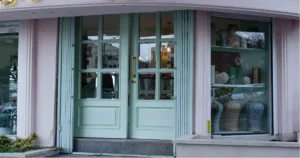Feature Of Many Haute Couture Dresses
Haute couture represents the pinnacle of fashion, where design, craftsmanship, and exclusivity create garments that are more than just clothing—they are works of art. The term “haute couture” translates from French as “high sewing” or “high dressmaking,” signifying a world of made-to-measure garments custom-tailored for individuals. Each piece is created with incredible attention to detail, using luxurious fabrics and hand-applied embellishments, ensuring every dress is one-of-a-kind.
In this article, we’ll explore the defining features that set haute couture dresses apart from all other forms of fashion, exploring the artistry, craftsmanship, and essence of what makes haute couture the most exclusive form of design in the world.
What is Haute Couture?
Before exploring haute couture details, it’s essential to understand the term. Haute couture, strictly regulated by the Chambre Syndicale de la Haute Couture in Paris, is an elite form of fashion that only a select few designers can produce. These fashion houses must create custom-fitted clothing for private clients, maintain ateliers (workshops) with a full-time staff in Paris, and present collections twice a year.
This world of exclusive fashion represents the highest echelon of luxury, where each piece is a unique creation made specifically for an individual. The garments are painstakingly crafted, often requiring weeks or months to complete. The following sections will explore the specific features that define haute couture dresses and explain why they are regarded as the ultimate in luxury fashion.
1. Custom-Fitted Garments
The most distinctive feature of haute couture is that every garment is tailored specifically to the client’s body. Unlike ready-to-wear clothing, haute couture is made-to-measure, crafted according to precise measurements to fit the wearer perfectly. Clients who commission a haute couture dress undergo multiple fittings to ensure that every garment seam, dart, and curve complements their unique body shape.
This attention to fit is what sets haute couture apart from mass-produced fashion. The perfect fit enhances the body’s silhouette and lets the wearer move comfortably. Each piece is designed to flatter, with the designer paying close attention to every inch of the client’s figure to create a harmonious relationship between the fabric and the body.
2. Handcrafted with Care
In haute couture, every garment is handcrafted from start to finish. This is one of the core principles distinguishing it from ready-to-wear fashion, which relies heavily on machines for mass production. In haute couture, skilled artisans work by hand to construct the entire garment. Every stitch, seam, and detail is executed precisely, often involving hundreds of hours of labor.
The atelier houses that specialize in haute couture employ artisans who have spent years mastering specific techniques, such as hand embroidery, lace-making, or beading. These artisans, known as petites mains (little hands), are the unsung heroes behind the scenes who bring the designer’s vision to life with their exceptional craftsmanship. The level of care and expertise involved ensures that each garment is beautiful, durable, and made to last.
3. Exclusive, High-Quality Fabrics
Another hallmark of haute couture dresses is the use of exclusive, high-quality fabrics. Designers often go to great lengths to source the finest materials, from silks and velvets to intricate lace and handwoven textiles. These fabrics are chosen for their beauty and ability to drape and move in a way that enhances the design.
In many cases, fabrics are custom-designed specifically for the dress. Designers may commission special weaves, colors, or patterns to create a unique garment. Haute couture fabrics undergo rigorous testing to meet the highest quality standards. This careful selection of fabrics is one of the reasons why haute couture garments exude such an air of luxury.
4. Intricate Embellishments
Haute couture dresses are often adorned with intricate embellishments, such as embroidery, beading, and appliqué, all of which are applied by hand. These embellishments require countless hours of labor and are executed with the highest level of craftsmanship. Whether it’s delicate lace overlays, shimmering sequins, or elaborately embroidered motifs, these details add a layer of depth and artistry to the garment.
The embellishments on haute couture dresses are not just decorative; they are an integral part of the design. They are carefully planned to complement the dress’s fabric, silhouette, and aesthetic. In some cases, designers collaborate with specialized embroidery houses, such as Lesage or Montex, to create bespoke embellishments that elevate the garment to a new level.
5. Creativity and Innovation
While haute couture adheres to traditional craftsmanship, it also serves as a platform for designers to showcase their creativity and push the boundaries of fashion. Haute couture collections often feature experimental designs, innovative silhouettes, and bold artistic concepts. Designers use haute couture as an opportunity to explore new ideas and techniques that may not be commercially viable for ready-to-wear collections.
This freedom allows for avant-garde creations that challenge conventional notions of beauty and style. From voluminous ball gowns to deconstructed dresses, haute couture allows designers to express their artistic visions without limitations. These designs often inspire trends that eventually trickle down into the broader fashion industry.
6. Attention to Detail
The attention to detail in haute couture dresses is second to none. Every garment element, from the lining to the closure, is executed with the utmost precision. Haute couture dresses often feature hand-sewn hems, invisible seams, and custom-made buttons or zippers chosen specifically for each garment.
No detail is overlooked in haute couture. Even the inner workings of the garment, such as the boning in corsets or the hidden layers of tulle in skirts, are carefully constructed to ensure the garment looks and feels perfect. This level of detail ensures that haute couture dresses are as beautiful on the inside as they are on the outside.
7. Exclusivity and Limited Production
One of the key aspects that define haute couture is its exclusivity. Each haute couture piece is made specifically for the client who commissions it, meaning no two dresses are alike. The exclusivity extends beyond the design and fit to the production process itself—there are no mass-produced versions of haute couture dresses.
Haute couture designers produce only a limited number of garments each season, and these pieces are often commissioned by the world’s elite for special events, such as red-carpet appearances or private galas. This limited production ensures that haute couture remains a symbol of ultimate luxury, reserved for those who seek and appreciate the highest levels of craftsmanship.
8. High Price Tag
Haute couture dresses come with a high price tag, often costing tens of thousands, if not hundreds of thousands, of dollars. The cost reflects the sheer amount of labor, time, and materials involved in creating each garment. From the hand-sewn details to the use of rare and luxurious fabrics, haute couture is an investment in artistry and craftsmanship.
The high cost also reflects the exclusivity of the piece—buyers know that they are getting something truly unique, created just for them, and crafted with the utmost care. For many clients, purchasing a haute couture dress is more than just owning a piece of clothing; it’s about owning a piece of fashion history.
9. Timeless and Durable
While fashion trends may come and go, haute couture is designed to stand the test of time. The craftsmanship and materials used in haute couture make these garments beautiful and durable. Haute couture dresses are often passed down through generations, becoming heirlooms cherished for their beauty and significance.
The timeless quality of haute couture is also reflected in the design. Many haute couture pieces are created with classic silhouettes and styles that remain elegant and relevant for decades. This focus on timelessness ensures that haute couture dresses can be worn repeatedly, making them a valuable investment for the buyer.
10. Cultural and Historical Significance
Haute couture holds a special place in the history and culture of fashion. It has been the cornerstone of fashion innovation for over a century, shaping how we think about luxury, style, and artistry. Many of the world’s most iconic fashion moments, from royal weddings to red-carpet appearances, have been marked by haute couture dresses that are as memorable as they are beautiful.
Designers like Christian Dior, Coco Chanel, Yves Saint Laurent, and Jean Paul Gaultier have left an indelible mark on the fashion world through their haute couture creations. These designers set trends and established haute couture as a symbol of cultural importance. Haute couture continues influencing fashion at all levels, from ready-to-wear collections to high-street fashion, ensuring its legacy endures.
Conclusion
Haute couture dresses are more than just clothing—they are masterpieces that represent the highest levels of craftsmanship, creativity, and luxury. Each piece is a testament to the skill and artistry of the designer and artisans who create it. From the use of the finest fabrics to the meticulous hand-sewn details, haute couture embodies the ultimate in bespoke fashion.
For those fortunate enough to wear haute couture, the experience is pure luxury and personal expression. These garments are not only made to fit but also to inspire awe and admiration. Haute couture remains at the forefront of the fashion world, setting the standard for what is possible when creativity, craftsmanship, and artistry come together in perfect harmony.
Frequently Asked Questions (FAQs)
What makes haute couture dresses different from ready-to-wear fashion?
Haute couture dresses are custom-made and handcrafted, ensuring a perfect fit for the client, unlike ready-to-wear fashion, which is mass-produced in standard sizes.
How long does it take to create a haute couture dress?
Due to intricate handwork and detailed craftsmanship, a haute couture dress can take several weeks to months to complete, depending on its complexity.
Why are haute couture dresses so expensive?
The high cost reflects luxury fabrics, extensive labor by skilled artisans, and the exclusivity of the made-to-measure design that ensures uniqueness.
Can anyone buy a haute couture dress?
Haute couture is typically reserved for a select clientele, as each garment is custom-made for private clients. However, some houses offer haute couture by appointment.
What kind of fabrics are used in haute couture dresses?
Only the finest fabrics, such as silk, velvet, lace, and satin, are used in haute couture, which is often custom-designed or sourced specifically for a particular garment.
Are haute couture dresses made to last?
Yes, haute couture garments are designed with longevity in mind, using high-quality materials and craftsmanship that ensure they can be worn and cherished for decades.







